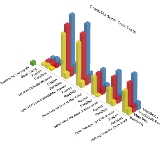
Comparison of VMware Fusion and Parallels Desktop
Encyclopedia
Represented by their respective products, VMware
and Parallels
are the two major commercial competitors in the Mac
consumer virtualization market. Both products are based on hypervisor
technology and allow users to run an additional 32- or 64-bit x86 operating system
in a virtual machine
alongside Mac OS X
on an Intel-powered Mac. The similarity in features and functionality between VMware Fusion
and Parallels Desktop for Mac
has given occasion for much comparison.
published the results of several benchmarks in which Fusion demonstrated better performance than Parallels Desktop for Mac in SMP-aware applications, which Fusion supports while Parallels does not. It should also be noted that Boot Camp is a tool for natively booting Windows XP on Intel Macintosh and is not a virtualization product. This comparison is of limited value today, as both products have had 2 major upgrades since then.
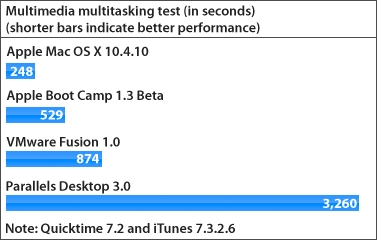
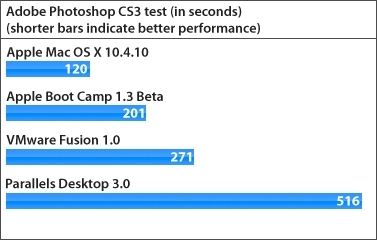
This comparison was tested on an eight-core, 2.66 GHz MacPro running Mac OS X 10.4.10
, Parallels Desktop 3.0 for Mac (build 4560) and VMware Fusion 1.0 (build 51348). Fusion and Parallels were both set to 1,024 MB of system memory and a 32 GB hard disk. Fusion was set to 128 MB of graphics memory, and Parallels Desktop for Mac was set to 64 MB of graphics memory (the maximum for each at that time).
, the editors published the results of one-step and task tests between VMware Fusion 1.0, Parallels Desktop 3.0 and Boot Camp and used a PC running Windows XP as a baseline comparison in a native PC environment.
MacTech found that the faster the physical host computer, the more similarly Parallels Desktop and VMware Fusion performed. MacTech did not test multiple processor performance. The following graphs displays the results in seconds. Shorter bars indicate faster performance.
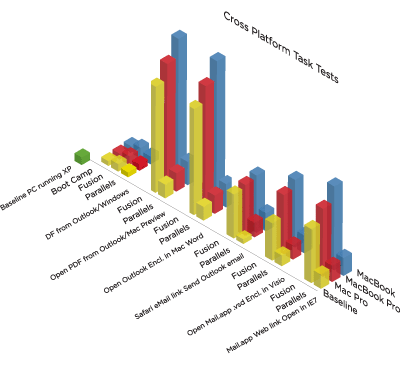
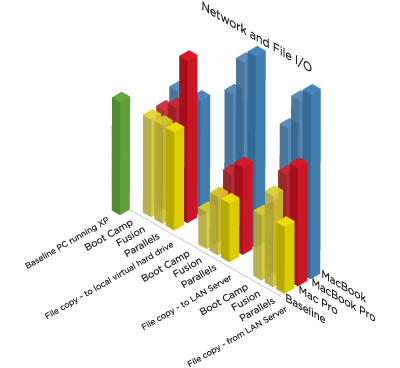
Each test was run on a MacBook
(2 GB RAM; 1.83 GHz Core Duo processor), a MacBook Pro
(4 GB RAM; 2.16 GHz Core 2 Duo processor) and a Mac Pro
(4 GB RAM; Quad Core configuration with two 2.66 GHz Dual-Core Intel Xeon processors). MacTech tested Parallels Desktop 3.0 for Mac Build 5160 and VMware Fusion 1.0 Build 51348.
All tests were done on clean host systems with new installations of Mac OS X 10.4.10 and Office installations and included all of the most up-to-date patches. No third party software was installed other than Mac OS X, VMware Fusion, Parallels Desktop, Windows XP
, Windows Vista
, Adobe Reader
and Microsoft Office
.
published the results of a new series of benchmark
tests that compared the performance between VMware Fusion 2.0.1 and Parallels Desktop 4.0 for Mac (build 3540), both running Mac OS X
10.5.5.
In most of MacTech’s tests, Parallels Desktop performed 14-20% faster than Fusion; however, Fusion ran 10% faster than Parallels Desktop when running Windows XP 32-bit on 2 virtual processors.
The tests were performed on the White MacBook
, MacBook Pro
, iMac
and MacPro. Both Fusion and Parallels Desktop were optimized for virtual machine performance. MacTech’s test included launch and CPU tests, File and Network IO, Footprint, Application Launch, Application Performance and 3D and HD Graphics. In many cases, tests were performed after both Adam and Successful launches and were timed using a stopwatch.
1 3D Games tested were Civilization IV
: Colonization and Portal. In Civilization, Parallels Desktop has faster FPS
(Frames Per Second) and performed better on slower machines while Fusion has better, more detailed graphics. Fusion has difficulty showing the startup video, but Parallels Desktop's graphics are not as rich. When running Portal, Fusion is faster but its graphics are visibly lighter, while Parallels Desktop has better graphics and visual details.
, Volume 26, Issue 01, published the results of a new series of benchmark
tests showing a performance advantage for Parallels Desktop 5 across all subcategories, with an average of 30% faster.
ITPro's November 2010 performance testing results were mixed, with Parallels being slightly faster, overall.
VMware
VMware, Inc. is a company providing virtualization software founded in 1998 and based in Palo Alto, California, USA. The company was acquired by EMC Corporation in 2004, and operates as a separate software subsidiary ....
and Parallels
Parallels, Inc.
Parallels, Inc. is a privately held virtualization technology company with offices in the USA, Germany, UK, France, Japan, China, Russia and Ukraine. Parallels' US offices are in Renton, WA.The company has more than 700 employees as of 2010....
are the two major commercial competitors in the Mac
Macintosh
The Macintosh , or Mac, is a series of several lines of personal computers designed, developed, and marketed by Apple Inc. The first Macintosh was introduced by Apple's then-chairman Steve Jobs on January 24, 1984; it was the first commercially successful personal computer to feature a mouse and a...
consumer virtualization market. Both products are based on hypervisor
Hypervisor
In computing, a hypervisor, also called virtual machine manager , is one of many hardware virtualization techniques that allow multiple operating systems, termed guests, to run concurrently on a host computer. It is so named because it is conceptually one level higher than a supervisory program...
technology and allow users to run an additional 32- or 64-bit x86 operating system
Operating system
An operating system is a set of programs that manage computer hardware resources and provide common services for application software. The operating system is the most important type of system software in a computer system...
in a virtual machine
Virtual machine
A virtual machine is a "completely isolated guest operating system installation within a normal host operating system". Modern virtual machines are implemented with either software emulation or hardware virtualization or both together.-VM Definitions:A virtual machine is a software...
alongside Mac OS X
Mac OS X
Mac OS X is a series of Unix-based operating systems and graphical user interfaces developed, marketed, and sold by Apple Inc. Since 2002, has been included with all new Macintosh computer systems...
on an Intel-powered Mac. The similarity in features and functionality between VMware Fusion
VMware Fusion
VMware Fusion is a virtual machine software product developed by VMware for Macintosh computers with Intel processors. Fusion allows Intel-based Macs to run x86 and x86-64 "guest" operating systems, such as Microsoft Windows, Linux, NetWare and Solaris as virtual machines simultaneously with Mac OS...
and Parallels Desktop for Mac
Parallels Desktop for Mac
Parallels Desktop for Mac by Parallels, Inc., is software providing hardware virtualization for Macintosh computers with Intel processors.-Overview:Parallels, Inc...
has given occasion for much comparison.
Features
| Feature | Product | |
|---|---|---|
 VMware Fusion 3.1 (4.0 is now released, this chart is out of date) |
Parallels Desktop 7 |
|
| Installing Windows on Mac | ||
| Easy Install with Automatic Windows Setup | ||
| Run off existing Boot Camp partition | ||
| Allows suspending of VM running off the Boot Camp partition | ||
| Import Physical Windows PC to VM | ||
| Import Boot Camp partition to VM | ||
| Full Support for Windows 7 | ||
| Import Third Party VMs (Parallels, VMware, VirtualPC for Mac) | ||
| Mac | ||
| Support Higher Synthetic screen resolutions in Full-Screen mode without scrolling (e.g. Run Windows in 1920x1200 mode on a 1440x900 monitor) | ||
| Migrate Windows 2000 PC to Mac | ||
| Migrate Windows XP to Mac | ||
| Migrate Windows 7 to Mac | ||
| Migrate Linux to Mac | ||
| Migrate PC over wireless network | ||
| Migrate PC over Ethernet | ||
| Migrate PC over FireWire | ||
| Migrate PC over USB | ||
| Windows documents migration to appropriate folders to Mac | ||
| Migration of the Internet bookmarks and settings from Internet Explorer, Firefox, or Chrome on PC to the default browser on the Mac. | ||
| Comes with Video Tutorials to help Windows Switchers on Mac | ||
| Running Windows Apps on Mac | ||
| Run Windows apps like Mac apps (Unity/Coherence) | ||
| Exclude Dock in Unity/Coherence | ||
| Windows application folder in Dock | ||
| Windows Start Menu in Dock | ||
| Windows application folder in menu bar | ||
| Windows Start Menu in menu | ||
| Always On Application Menu available to launch Windows apps at any time | ||
| Quit Individual Window applications | ||
| Use Command ` to switch between open windows in a Windows app | ||
| Assign Windows applications to a Mac OS X Space | ||
| Shared Folders to access Mac files/folders from Windows | ||
| Access Windows tray icons in Unity | ||
| Arrow icon in the Mac menu bar for customizing Windows tray icons in Coherence. | ||
| Progress for downloads and other operations is displayed on the Windows 7 applications icons in the Dock. | ||
| Windows 7 Jump Lists are supported for Windows applications in the Dock: view your recent documents by right-clicking the application icon in the Dock. | ||
| Grouping of all windows of a single Windows application under the same application icon in the Dock. | ||
| Active screen corners | ||
| Launch Windows or Mac internet applications from hyperlinks | ||
| Windows applications can be set as the default applications for handling CDs and DVDs inserted into the Mac. | ||
| Enable Apple Gestures to work with Windows applications | ||
| Enable Apple Magic Mouse Gesture support with Windows applications | ||
| Enable Apple Remote to work with Windows applications | ||
| Launch Mac applications from any Windows file (Shared Applications/SmartSelect) | ||
| Automatically mount storage and network devices to guest OS | ||
| Suspend/Resume To Where You Last Left Off | ||
| Pause VM if no application running to reduce Mac OS load. | ||
| Mirrored/Remapped Desktop, Music, Documents, and Pictures Folders | ||
| Contextual menu items "Run on Mac" and "Show in Finder" for Shared Folders | ||
| Remapping Windows Keyboard Shortcuts to Mac Shortcuts | ||
| Keyboard shortcut (F6 or Fn + F6) for hiding/showing Parallels Desktop and all its windows. | ||
| Virtual Links - aliases to Mac OS files from Windows virtual machines | ||
| Copy/Paste Text between Windows / Mac | ||
| Drag and Drop Text between Windows / Mac | ||
| Drag and Drop Files Between Windows / Mac | ||
| Copy/Paste Graphics between Windows / Mac | ||
| Passthrough "Driverless" Printing to Mac Printers | ||
| Making Windows Safer on Mac | ||
| Single Snapshot support | ||
| Multiple Snapshot support | ||
| AutoProtect Automatic Snapshots | ||
| TimeMachine backups can be synced with SmartGuard snapshots, to reduce the space required for backups. | ||
| Automatically revert VM to start state upon termination | ||
| Virtual machine encryption with AES algorithm for better security of your data (empowered by AES-NI hardware support on i5 and i7 CPUs) | ||
| Mac OS Parental Controls are automatically applied to the virtual machine for managing children’s computer usage | ||
| Windows AntiVirus & AntiSpyware Included | ||
| Mac OS AntiVirus Included | ||
| Lock down application and virtual machine settings to prevent changes | ||
| Isolated Virtual Machines | ||
| Designed for Mac (Fit and Finish) | ||
| Optimized for Lion | ||
| Optimized for Snow Leopard | ||
| UI Built from Ground Up for Mac | ||
| Welcome Screen to Simplify Initial Setup | ||
| Mac-like Settings and Preferences Windows | ||
| Apply different colors to virtual machines to find them in Finder or in the virtual machines list | ||
| Customizable Toolbars | ||
| Default virtual machine to launch on application startup | ||
| Virtual Machine Library | ||
| Live View of Running Virtual Machines in Library/Settings | ||
| Live View of Running Virtual Machine in Dock | ||
| Startup in Last View Format | ||
| Reduce the virtual hard disk size as its unused space grows | ||
| Apple Help (Searchable with Mac Design) | ||
| Single File Virtual Machine Packages | ||
| QuickLook/Cover Flow Integration | ||
| Mount Running Virtual Machines in Finder | ||
| Mount Stopped Virtual Machines in Finder | ||
| Use iSight in OS X and Windows | ||
| Advanced Platform | ||
| 32-bit Guest Operating Systems | ||
| 64-bit Guest Operating Systems | ||
| Multi-CPU virtual machines | ||
| Virtual CPU supports AES-NI when running on i5 and i7 CPUs | ||
| Maximum RAM per virtual machine | ||
| Support for IPv6, the next-generation version of the Internet Protocol, in shared, bridged and host-only networking. | ||
| Windows Aero (WDDM for Windows Vista and Windows 7) | ||
| DirectX 3D Graphics Support | ||
| OpenGL 3D Graphics Support for Windows Vista & Windows 7 guest OS | ||
| OpenGL 3D Graphics Support for Windows XP guest OS | ||
| OpenGL 3D Graphics Support for Linux guest OS | ||
| Multiple monitor/display support | ||
| Hardware Assisted Video/Movie Playback | ||
| Maximum video RAM per VM | ||
| USB 2.0 passthrough support | ||
| Support for external surround sound 5.1 USB or FireWire devices work simultaneously in Mac and the virtual machine. | ||
| 64-bit Native Engine | ||
| Power Management/Battery Passthrough | ||
| Bluetooth support (as USB device) | ||
| Firewire passthrough support | ||
| Virtual IDE Controller | ||
| Virtual SCSI Controller | ||
| Virtual SAS Controller | ||
| Shared Smart Card | ||
| Low Level Access to Network Interfaces (promiscuous mode / WiFi monitor mode etc.) | ||
| Advanced Tools | ||
| Virtual Disk Management | ||
| Resize Virtual Disks | ||
| Advanced Network Management | ||
| Control VMs with Scripting option | ||
| Supports Intel VT-x hardware virtualization engine | ||
| Network (PXE) Boot | ||
| Run More Operating Systems on Mac | ||
| Run Multiple Operating Systems at One Time | ||
| Supported x86 Operating Systems | ||
| Run Linux virtual machines | ||
| Linux Easy Install with Automatic Setup | ||
| Linux virtual machine support | ||
| Run Linux apps like Mac apps with Unity/Coherence | ||
| Run Mac OS X Server virtual machines | ||
| Import VHD Test Drives | ||
| Run Virtual Appliances | ||
| iPhone/iPad mobile client | ||
| Allows to work with remote VM on iPhone/iPad | ||
| Allows user to connect over internet |
Minimum system requirements
| Requirement | Product | |
|---|---|---|
| VMware Fusion 3.1 | Parallels Desktop 7 | |
| Host OS | Mac OS X 10.5.8 or later; Mac OS X 10.6 or later | Mac OS X 10.5.8 or later; Mac OS X 10.6 or later; OS X 10.7 or later |
| RAM | 1 GB (2 GB Recommended) | 1 GB (2 GB Recommended) |
| Disk space for product | 700 MB | 450 MB |
2007 Benchmark tests
On August 16, 2007, CNETCNET
CNET is a tech media website that publishes news articles, blogs, and podcasts on technology and consumer electronics. Originally founded in 1994 by Halsey Minor and Shelby Bonnie, it was the flagship brand of CNET Networks and became a brand of CBS Interactive through CNET Networks' acquisition...
published the results of several benchmarks in which Fusion demonstrated better performance than Parallels Desktop for Mac in SMP-aware applications, which Fusion supports while Parallels does not. It should also be noted that Boot Camp is a tool for natively booting Windows XP on Intel Macintosh and is not a virtualization product. This comparison is of limited value today, as both products have had 2 major upgrades since then.


This comparison was tested on an eight-core, 2.66 GHz MacPro running Mac OS X 10.4.10
Mac OS X v10.4
Mac OS X v10.4 Tiger is the fifth major release of Mac OS X, Apple's desktop and server operating system for Macintosh computers. Tiger was released to the public on 29 April 2005 for US$129.95 as the successor to Mac OS X Panther , which had been released 18 months earlier...
, Parallels Desktop 3.0 for Mac (build 4560) and VMware Fusion 1.0 (build 51348). Fusion and Parallels were both set to 1,024 MB of system memory and a 32 GB hard disk. Fusion was set to 128 MB of graphics memory, and Parallels Desktop for Mac was set to 64 MB of graphics memory (the maximum for each at that time).
2008 Benchmark tests
In Volume 24, Issue 02 of MacTechMacTech
MacTech is the journal of Apple technology, a monthly magazine for software developers, system administrators, and other technical users of the Apple Macintosh line of computers....
, the editors published the results of one-step and task tests between VMware Fusion 1.0, Parallels Desktop 3.0 and Boot Camp and used a PC running Windows XP as a baseline comparison in a native PC environment.
- One-step Test: After clicking the mouse or pressing a key, this test requires no further human action.
- Task Test: This tests the interaction between Mac OS X and the virtual environment and requires multiple tests throughout the process.
MacTech found that the faster the physical host computer, the more similarly Parallels Desktop and VMware Fusion performed. MacTech did not test multiple processor performance. The following graphs displays the results in seconds. Shorter bars indicate faster performance.


Each test was run on a MacBook
MacBook
The MacBook was a brand of Macintosh notebook computers built by Apple Inc. First introduced in May 2006, it replaced the iBook and 12-inch PowerBook series of notebooks as a part of the Apple–Intel transition. Positioned as the low end of the MacBook family, the Apple MacBook was aimed at the...
(2 GB RAM; 1.83 GHz Core Duo processor), a MacBook Pro
MacBook Pro
The MacBook Pro is a line of Macintosh portable computers introduced in January 2006 by Apple. It replaced the PowerBook G4 and was the second model, after the iMac, to be announced in the Apple–Intel transition...
(4 GB RAM; 2.16 GHz Core 2 Duo processor) and a Mac Pro
Mac Pro
The Mac Pro is a workstation computer manufactured by Apple Inc. The machines are based on Xeon microprocessors, but are similar to the Power Mac G5 they replaced in terms of outward appearance and expansion capabilities...
(4 GB RAM; Quad Core configuration with two 2.66 GHz Dual-Core Intel Xeon processors). MacTech tested Parallels Desktop 3.0 for Mac Build 5160 and VMware Fusion 1.0 Build 51348.
All tests were done on clean host systems with new installations of Mac OS X 10.4.10 and Office installations and included all of the most up-to-date patches. No third party software was installed other than Mac OS X, VMware Fusion, Parallels Desktop, Windows XP
Windows XP
Windows XP is an operating system produced by Microsoft for use on personal computers, including home and business desktops, laptops and media centers. First released to computer manufacturers on August 24, 2001, it is the second most popular version of Windows, based on installed user base...
, Windows Vista
Windows Vista
Windows Vista is an operating system released in several variations developed by Microsoft for use on personal computers, including home and business desktops, laptops, tablet PCs, and media center PCs...
, Adobe Reader
Adobe Acrobat
Adobe Acrobat is a family of application software developed by Adobe Systems to view, create, manipulate, print and manage files in Portable Document Format . All members of the family, except Adobe Reader , are commercial software, while the latter is available as freeware and can be downloaded...
and Microsoft Office
Microsoft Office
Microsoft Office is a non-free commercial office suite of inter-related desktop applications, servers and services for the Microsoft Windows and Mac OS X operating systems, introduced by Microsoft in August 1, 1989. Initially a marketing term for a bundled set of applications, the first version of...
.
2009 Benchmark tests
In March, 2009, Volume 25, Issue 04, MacTechMacTech
MacTech is the journal of Apple technology, a monthly magazine for software developers, system administrators, and other technical users of the Apple Macintosh line of computers....
published the results of a new series of benchmark
Benchmark (computing)
In computing, a benchmark is the act of running a computer program, a set of programs, or other operations, in order to assess the relative performance of an object, normally by running a number of standard tests and trials against it...
tests that compared the performance between VMware Fusion 2.0.1 and Parallels Desktop 4.0 for Mac (build 3540), both running Mac OS X
Mac OS X
Mac OS X is a series of Unix-based operating systems and graphical user interfaces developed, marketed, and sold by Apple Inc. Since 2002, has been included with all new Macintosh computer systems...
10.5.5.
In most of MacTech’s tests, Parallels Desktop performed 14-20% faster than Fusion; however, Fusion ran 10% faster than Parallels Desktop when running Windows XP 32-bit on 2 virtual processors.
| OS/Environment | Result |
|---|---|
| Windows XP, 32-bit, 1 Processor | Parallels Desktop runs 14% faster |
| Windows Vista, 32-bit, 1 Processor | Parallels Desktop runs 14% faster |
| Windows XP, 32-bit, 2 Processors | VMware Fusion runs 10% faster |
| Windows Vista, 32-bit, 2 Processors | Parallels Desktop runs 20% faster |
| Windows XP, 64-bit, 2 Processors | Parallels Desktop runs 15% faster |
The tests were performed on the White MacBook
MacBook
The MacBook was a brand of Macintosh notebook computers built by Apple Inc. First introduced in May 2006, it replaced the iBook and 12-inch PowerBook series of notebooks as a part of the Apple–Intel transition. Positioned as the low end of the MacBook family, the Apple MacBook was aimed at the...
, MacBook Pro
MacBook Pro
The MacBook Pro is a line of Macintosh portable computers introduced in January 2006 by Apple. It replaced the PowerBook G4 and was the second model, after the iMac, to be announced in the Apple–Intel transition...
, iMac
IMac
The iMac is a range of all-in-one Macintosh desktop computers built by Apple. It has been the primary part of Apple's consumer desktop offerings since its introduction in 1998, and has evolved through five distinct forms....
and MacPro. Both Fusion and Parallels Desktop were optimized for virtual machine performance. MacTech’s test included launch and CPU tests, File and Network IO, Footprint, Application Launch, Application Performance and 3D and HD Graphics. In many cases, tests were performed after both Adam and Successful launches and were timed using a stopwatch.
| Test Suite | Performance Winner |
|---|---|
| Windows Launch Performance | Parallels Desktop for Mac |
| CPU | Parallels Desktop for Mac, except for 2 of the 14 tests |
| Footprint on Mac | Parallels Desktop for Mac |
| Application Launch | VMware Fusion |
| Application Performance | Both products did well, except for IE where Parallels Desktop is 80-91% faster |
| 3D and HD Performance | Dependent on game1, video and Windows environment. |
1 3D Games tested were Civilization IV
Civilization IV
Sid Meier's Civilization IV is a turn-based strategy, 4X computer game released in 2005 and developed by lead designer Soren Johnson under the direction of Sid Meier and Meier's studio Firaxis Games. It is the fourth installment of the Civilization series...
: Colonization and Portal. In Civilization, Parallels Desktop has faster FPS
Frame rate
Frame rate is the frequency at which an imaging device produces unique consecutive images called frames. The term applies equally well to computer graphics, video cameras, film cameras, and motion capture systems...
(Frames Per Second) and performed better on slower machines while Fusion has better, more detailed graphics. Fusion has difficulty showing the startup video, but Parallels Desktop's graphics are not as rich. When running Portal, Fusion is faster but its graphics are visibly lighter, while Parallels Desktop has better graphics and visual details.
Cross-platform task tests
MacTech’s cross platform tests timed how long it took users to perform multi-step tasks that moved data between Mac OS X and Windows. VMware Fusion, which is designed for increased isolation from the host, requires more manual steps to move data between the host and the virtual environment. Parallels Desktop, which is designed to run transparently with the Mac OS X host, requires fewer steps to perform the same tasks. Therefore, Parallels Desktop was faster.Networking and file I/O tests
Parallels Desktop occasionally displayed lag anomalies while VMware Fusion's virtual drive performance was very close to that of a physical drive. VMware Fusion preferred a bridged connection for reliable performance, and Parallels Desktop was consistent regardless of the type of virtual network adaptor used.Simultaneous use of VM and host OS
Parallel Desktop 5 always uses wired memory for hosted OS, while VMWare Fusion 3.0 uses active memory that can be swapped. Giving better performance to hosted VM, this leaves less memory to host OS programs and causes more swapping if you use VM and host OS programs at the same time.2010 Benchmark tests
In 2010 MacTechMacTech
MacTech is the journal of Apple technology, a monthly magazine for software developers, system administrators, and other technical users of the Apple Macintosh line of computers....
, Volume 26, Issue 01, published the results of a new series of benchmark
Benchmark (computing)
In computing, a benchmark is the act of running a computer program, a set of programs, or other operations, in order to assess the relative performance of an object, normally by running a number of standard tests and trials against it...
tests showing a performance advantage for Parallels Desktop 5 across all subcategories, with an average of 30% faster.
ITPro's November 2010 performance testing results were mixed, with Parallels being slightly faster, overall.
See also
- VirtualBoxVirtualBoxOracle VM VirtualBox is an x86 virtualization software package, originally created by software company Innotek GmbH, purchased by Sun Microsystems, and now developed by Oracle Corporation as part of its family of virtualization products...
- Comparison of platform virtual machines for a list of related virtualization software products
- Desktop virtualizationDesktop virtualizationDesktop virtualization , as a concept, separates a personal computer desktop environment from a physical machine using the client–server model of computing....
- Microsoft Virtual PCMicrosoft Virtual PCWindows Virtual PC is a virtualization program for Microsoft Windows. In July 2006 Microsoft released the Windows-hosted version as a free product...
- Platform virtualization
- Virtual machineVirtual machineA virtual machine is a "completely isolated guest operating system installation within a normal host operating system". Modern virtual machines are implemented with either software emulation or hardware virtualization or both together.-VM Definitions:A virtual machine is a software...
- x86 virtualizationX86 virtualizationIn computing, x86 virtualization is the facility that allows multiple operating systems to simultaneously share x86 processor resources in a safe and efficient manner, a facility generically known as hardware virtualization...

